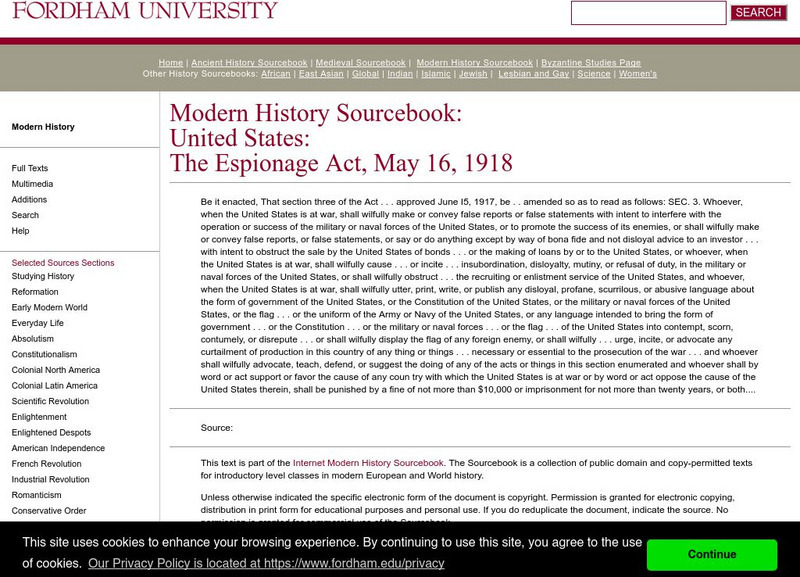George Mason University
George Mason University: Between the Wars: Wwi and the Crusade for Conformity
The text of 3 U.S. Supreme Court cases on Free Speech during WWI. These cases deal with literature criticising the U.S. involvement in WWI. Includes the text of the Espionage Act under which war protesters were arrested.
Annenberg Foundation
Annenberg Classroom: Civil Liberties in War
This resource provides extensive information for students and teachers examining the issue of civil liberty during wartime and in the fight against terrorism in the U.S. following September 11. Resources include news articles, legal...
Stanford University
Sheg: Document Based History: Reading Like a Historian: Sedition in World War I
[Free Registration/Login Required] Students read primary source documents to solve a problem surrounding a historical question. This document-based inquiry lesson allows students to read anti-war literature from World War I critics to...
Curated OER
History Matters: Get the Rope! Anti German Violence in World War I Era Wisconsin
Read this harrowing account of a German-American farmer whose nativist neighbors suspected his alliegiance to the United States after the country entered the war against Germany in World War I.
Digital History
Digital History: Espionage and Sedition Acts
Suspension of civil liberties by the government is always a radial act. Read about why President Wilson and the Congress thought this was necessary upon the U.S. entrance to World War I, and see who really suffered from the enforcement...
Northern Illinois University
Ishs: The Espionage and Sedition Acts of 1917 and 1918 [Pdf]
From the 1994 spring volume of the Illinois Historical Journal comes this interesting and somewhat shocking account of how those who did not agree with the U.S. involvement in World War I were treated. Read how the basic right of freedom...
PBS
American Experience: Espionage and Sedition Acts
As progressive a president as Woodrow Wilson was, when the U.S. joined World War I, he signed legislation that made it a crime to criticize the government. Read about the espionage and sedition acts that were passed and how they were...
Independence Hall Association
U.s. History: America in the Second World War
A brief description of the course of World War II in both Europe and the Pacific. Read about the new technologies developed for the military by both the Allies and Axis powers, and find out about the millions who died as a result of the...
Internet History Sourcebooks Project
Fordham University: Modern History Sourcebook: United States: The Espionage Act, 1918
Find the text of the amended Section 3 of the Espionage Act.
Independence Hall Association
U.s. History: Japanese American Internment
After the Japanese attack on Pearl Harbor, fear of Japanese-Americans irrationally increased, resulting in Roosevelt's executive order that created internment camps for American citizens. Read about the camps, the life in the camps, and...
Brigham Young University
World War I Document Archive: The u.s. Sedition Act
Find the text of the U.S. Sedition Act, section three of the Espionage Act passed during World War I.
PBS
Pbs Teachers: The Rights of Detainees at Guantanamo Bay (Lesson Plan)
A lesson for investigating the clashing concerns of civil liberties and national security during wartime. Students will identify the legal issues involved with detaining terrorism suspects at Guantanamo Bay, Cuba.







![Ishs: The Espionage and Sedition Acts of 1917 and 1918 [Pdf] Handout Ishs: The Espionage and Sedition Acts of 1917 and 1918 [Pdf] Handout](https://d15y2dacu3jp90.cloudfront.net/images/attachment_defaults/resource/large/FPO-knovation.png)




